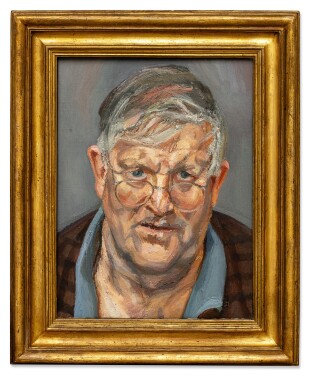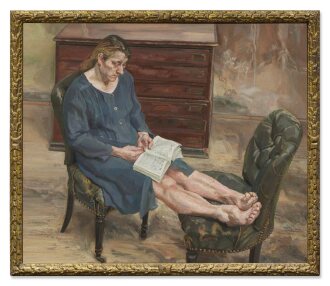Works by Lucian Freud at Sotheby's
Lucian Freud Biography
Known for his evocative and unflinching portrait paintings, Lucian Freud has come to be recognized as one of the most important figurative painters of the 20th century. Freud—grandson of the psychoanalyst Sigmund Freud—was born in Berlin, Germany, in 1922, but his family relocated to London, England, in 1933 to escape the rise of Adolph Hitler. Freud had begun making art as a small child before the relocation, and he began exhibiting at a very young age; a drawing from 1930, when the artist was eight, was shown at Peggy Guggenheim’s gallery in London in 1938, when he was only 16.
Although fairly precocious, Freud had an unruly streak that led to expulsion from several schools as a teenager. He ultimately enrolled and began formal training in art at the East Anglican School of Painting and Drawing in Essex in 1939. Following his studies, and a brief stint in the Merchant Navy, he completed his first major painting, The Painter’s Room, in 1944, done in the Surrealist mode. Shortly thereafter, he spent some time in Europe, and in Paris in 1946 he met artists such as Pablo Picasso and Alberto Giacometti.
Once Freud had returned to London, he eventually joined the faculty of the Slade School of Art. The artist was well known for his tempestuous personality and scandalous behavior; he married several times, and fathered as many as fourteen children between his wives and upwards of twelve mistresses. Many described his treatment of those closest to him as abhorrent—as his friend Geordie Greig described, “Lucian simply never examined his conscience.” Despite this, Freud was quite popular within the London art world, and was well known amongst the cities elite.
He soon began focusing his professional attention on portraiture, painting only those who were within his inner circle. His signature style, marked by thick paint application and a preoccupation with both the physical and psychological flaws of his sitter, developed through his progressive works. He experimented with different types of brushes and the situation of the canvas on his easel. His nudes, which would come to dominate his oeuvre, were nearly always considered unflattering (and his portraits of children have been the subject of great controversy). Nevertheless, his unique approach captured the attention of many, and he was the subject of a travelling retrospective in 1987 that catapulted him to international fame. He subsequently completed a number of high-profile portraits, including of Queen Elizabeth II.
His raucous behavior conduct and persona did not dull with age—he was named one of the most eligible bachelors by British tabloid Tattler in his eighties—and he continued to create rather shocking portraits through the aughts until his death in 2011.
Freud’s oeuvre has had a tremendous stylistic impact on subsequent generations, in many ways creating a precedent for painting that demands rule breaking and disregarding expectation. His works have been acquired by numerous prestigious public collections, including the Museum of Modern Art, New York; the National Gallery of Art, Washington, DC; and the Centre Pompidou, Paris. A 1987 exhibition at the Hirshorn raised his stature in the United States. In 1993 the the Metropolitan Museum of Art mounted a retrospective of his work.
Read Less











